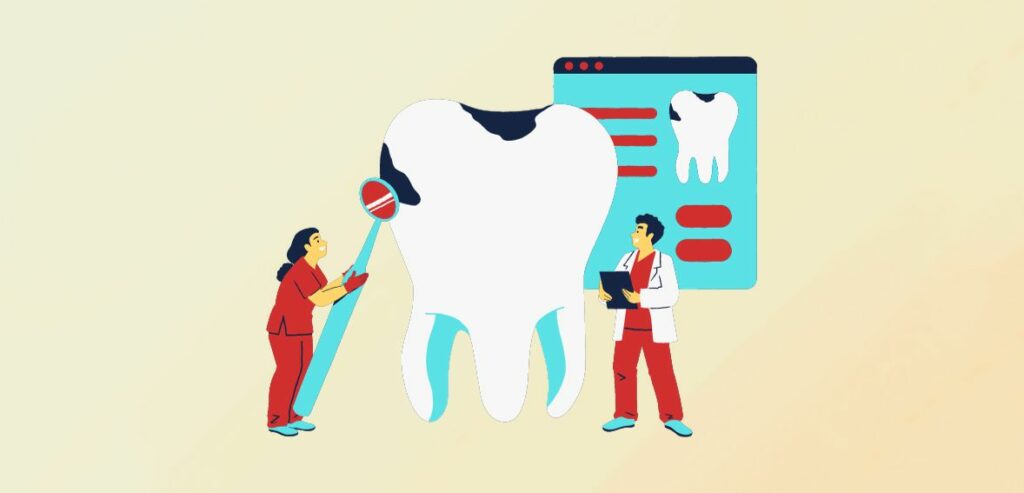Cosmetic dentistry encompasses procedures aimed at enhancing the aesthetics of teeth, bites, or gums. While some focus on improving smiles, others, like crowns, dental implants, or Invisalign braces, offer aesthetic and functional benefits. Regardless of their impact on dental health, these procedures have proven to boost confidence and potentially enhance the overall quality of life.
However, one significant obstacle those considering cosmetic dental treatments often face is the associated cost. Traditional health and dental insurance typically don’t cover elective cosmetic procedures, leaving patients to explore alternative payment methods. Complicating matters is that approximately 68.5 million US adults don’t even have dental insurance, further limiting financial assistance.
To address these challenges, flexible and convenient patient payment options for cosmetic dentistry have emerged, enhancing accessibility to both traditional and cosmetic dentistry treatments. In this article, we’ll explore some of these payment alternatives, empowering you to make an informed, health-conscious decision for a brighter, healthier smile.
What Exactly Is Cosmetic Dentistry?
If you want to enhance your smile, cosmetic dentistry offers a range of solutions. This specialized field of oral care focuses on enhancing the overall appearance of the teeth and gums – giving you the perfect smile. Procedures such as veneers, teeth whitening, implants, and fillings are commonly sought after.
The popularity of cosmetic dentistry is rising, with the industry expected to reach a value of $41.60 billion by 2030. While not medically necessary, these treatments can significantly boost your confidence and satisfaction with your smile.

How is it different from general dentistry?
A general dentist is your main dental care provider, offering essential services like routine cleanings and treatments to repair damaged teeth, such as fillings, crowns, and bridges.
While these procedures address both the health and look of the teeth, a cosmetic dentist specifically concentrates on enhancing the aesthetic appeal of your smile, providing treatments designed to improve your teeth and gums’ appearance.
Understanding The Types Of Cosmetic Dentistry
Cosmetic dentistry focuses on teeth’s appearance, offering treatments that can also provide functional benefits in certain cases. Here are some common types:
- Teeth Whitening ($500 to $1,000 per session):
Teeth can be stained by dark-colored foods and drinks like tea, berries, or coffee over time. Professional teeth whitening offers a safe and dramatic solution to lighten the shade of teeth, brightening your smile.
Dentists provide both at-home and in-office options. In-office sessions typically take about an hour, while at-home treatments span several weeks.
- Inlays and Onlays ($650 to $1,200 per tooth):
Also known as indirect fillings, inlays, and onlays are made in a dental lab and used when a tooth has moderate decay or lacks enough structure for a regular filling. If the tooth’s cusps are intact, an inlay is placed on the tooth’s surface. However, if more of the tooth is damaged, an onlay covers the entire surface.
Made from materials like porcelain or ceramic, these inlays and onlays strengthen teeth, restore their shape, and help prevent further decay. They are bonded to the teeth using special dental cement.
- Dental Bonding ($300 and $600 per tooth):
Dental bonding utilizes tooth-colored composite resin applied by your dentist. This material helps cover and conceal cosmetic imperfections such as cracks, craze lines, and discoloration. Moreover, dental bonding can alter the shape of a tooth, making it longer, wider, or more uniform.
The procedure generally needs replacement every five to seven years and is entirely reversible, as it doesn’t require the removal of natural tooth enamel.
- Gum Contouring ($50 to $350 per tooth):
In some cases, individuals have an excess of gum tissue, leading to what’s often described as a “gummy” smile. Gum contouring addresses this by removing the extra gum tissue and refining the gum line, resulting in a more harmonious and balanced smile.
- Porcelain Veneers ($925 to $2,500):
Porcelain veneers are thin yet durable shells crafted from medical-grade ceramic. These shells are bonded to the front of the teeth, offering solutions to various cosmetic issues such as cracks, discoloration, or chips.
Veneers come in different types, including traditional and minimal prep. While all types involve some enamel removal, making the process potentially reversible, they typically last around 10 years before needing replacement.
- Dental Implants ($3,000 and $4,500):
Dental implants are a long-lasting solution for severe tooth decay or loss. The process includes attaching a screw to the jawbone for stability, followed by inserting the implant into the bone socket of the missing tooth.
As time progresses, the bone and implant integrate, securely anchoring the replacement tooth. Once fully fitted, the dental implant should seamlessly blend with your real teeth.
- Tooth Contouring ($50 and $300 per tooth):
Tooth contouring is a straightforward procedure aimed at reshaping your teeth by removing minimal enamel. Given that natural enamel is limited, there are boundaries to how much your dentist can reshape. The good news is that this treatment typically wraps up in just one office visit.
Different Payment Options For Cosmetic Dentistry

Here are some popular payment options for Cosmetic Dentistry:
1. Cosmetic Dentistry Grant
A Cosmetic Dentistry Grant (CDG) offers a helping hand to individuals seeking to enhance their smiles. These grants are available at no cost and aim to assist people from various backgrounds in achieving better oral health and a more radiant smile through cosmetic dentistry. The application process for a CDG program is straightforward, with cosmetic treatments like implants, veneers, teeth whitening, Invisalign, and more. Eligibility verification and a professional assessment are part of the application, ensuring the necessity of services and overall oral health. While the grant is open to anyone seeking cosmetic dental treatment, the program is competitive.
To get started, you can request a complimentary oral health check-up from a certified practitioner in your local dental clinic. This assessment will determine if you have any oral health concerns and are eligible for cosmetic treatments. Please note that there may be charges for X-rays during this assessment.
Once the preliminary check-up is complete and the basic dental care is in order, if you’re deemed a suitable candidate for cosmetic procedures like tooth implants, the dental team will endorse you for the CDG program and lay out a personalized treatment plan for your implants.
But what are the eligibility requirements for CDG grants?
- Applicants must be at least 18 years old at the time of application.
- Applicants must be legal residents of any of the US states.
- Applications are available only for dental offices within a 60-mile radius of the applicant.
- All interested individuals must complete an application form regardless of income or background.
- Grant recipients must sign liability and publicity release forms.
- Funds awarded may be forfeited if the signed affidavit isn’t returned within 30 days of notification.
2. Traditional Credit Cards
If you don’t have access to a healthcare-specific credit card or can’t get one, don’t fret. The traditional credit card in your wallet can still be an option. However, it’s crucial to tread carefully, especially for significant medical procedures. Start by setting up a budget. Knowing exactly how much you can afford to pay each month will help you avoid financial strain. Keep a close eye on your credit card’s limit to ensure you don’t exceed it, as doing so can result in additional fees.

Interest rates are another factor to consider. Ideally, you’d want to use a credit card that offers a 0% interest rate for a certain period. This can give you some breathing room to pay off the medical expenses without accumulating extra costs.
But how to pay with a credit card?
POS systems are the go-to method for paying with a credit card at a cosmetic dentistry office. Whether they’re simple or packed with features, these devices are what you’ll encounter when you’re ready to swipe your card at the reception desk and enter the pin or you can tap and pay in some systems.
3. In-House Financing
In-house financing is when a dental office offers to finance the cost of treatment directly for its patients. Essentially, the dental practice becomes the lender, creating a payment plan that helps patients manage the expense over time.
This approach has its benefits for dental offices, like fostering stronger relationships with patients and assisting those who might struggle to get financing elsewhere due to credit issues. However, there are challenges too, such as handling the financing process internally, dealing with potential payment defaults, and covering extra administrative costs.
It typically works simply, the dental office sets up a payment schedule for the patient, often with added interest or fees. This plan aims to be manageable, spreading the cost over months or even years. Some places even offer zero-interest options to make it more accessible.
But does dental in-house financing impact your credit score?
The way financing through a dental office affects your credit score can vary. Some financing providers start with a soft credit check for pre-approval but switch to a hard credit check later. While a soft check doesn’t appear on your credit report, a hard check can lower your score by a few points.
To safeguard your patients’ credit scores, opt for a provider that solely relies on soft credit checks. Additionally, ensure timely repayments to avoid late fees and any negative impact on credit ratings.
4. Third-Party Financing
Dental offices sometimes collaborate with external lenders to give patients more ways to finance their treatments. This partnership lets patients apply for a loan through a third-party lender. If they get approved, the lender covers the dental fees upfront. Afterward, patients repay the lender in installments, often with added interest and fees.
This approach has its perks for dental practices, like offering diverse financing choices and lessening the risk of missed payments. Yet, it also comes with downsides, including extra fees from the outside lender and the chance that patients might feel less loyal to the practice. If your dental service provider does not offer third-party financing, you can apply for these lending options.
But how can you apply for third-party financing yourself?
- Check Your Options: Explore various online lenders to compare interest rates and offers. Look for the most affordable option that suits your needs.
- Make Your Choice: Once you’ve found a suitable lender, select a loan that aligns with your budget and covers your dental expenses. Consider factors like interest rates, monthly payments, and the loan term.
- Apply Carefully: You can usually apply online with many lenders, though some traditional banks might require an in-person visit. Before submitting your application, ensure you understand all terms and conditions. Be aware that a hard credit check will be performed, potentially causing a slight dip in your credit score.
5. Dental Credit Cards
Dental credit cards are designed to assist with dental expenses when insurance isn’t an option. They allow you to spread out payments over time rather than paying everything at once. These cards are specifically for dental costs, covering items like copays and other out-of-pocket expenses not handled by insurance.
Some cards even offer a zero-interest period, often up to 24 months. If you pay off your balance within this timeframe, you won’t incur any interest charges. Applying for such a card is usually straightforward and can often be done online, with some places offering instant approval for immediate dental needs. However, it’s wise to research your options carefully before making a decision.
What are the best dental credit cards out there?
- Amex EveryDay Card: If you want to earn rewards on your dental payments, consider the Amex EveryDay Card. This American Express card is designed for those who want a straightforward rewards program without a lot of hassle.
- CareCredit: Specifically tailored for medical and dental costs, CareCredit allows you to manage both elective and essential treatments. It offers monthly payment plans and is accessible to people with credit scores ranging from fair to excellent.
- Chase Freedom Unlimited Visa: This card from Chase Bank provides cashback rewards and a few extra perks. Notably, it offers an extended 0% introductory APR period for balance transfers and new purchases, giving you more time to manage your expenses without accruing interest.

6. FSA and HSA
Flexible Spending Accounts (FSAs) and Health Savings Accounts (HSAs) offer a tax-advantaged way to pay for various medical expenses, including dental care. By contributing to these accounts, you can use the funds to cover eligible dental treatments without paying taxes on the money you use. This includes routine check-ups and procedures like braces or other cosmetic dentistry services that insurance might not fully cover.
These accounts can be a financial lifesaver for those familiar with hefty dental bills, such as root canals or orthodontic work. Here are some common dental services that your HSA or FSA typically covers:
- X-rays
- Dental implants (excluding purely cosmetic ones like veneers)
- Dental crowns
- Gum treatments
Conclusion
Cosmetic dentistry offers a spectrum of treatments designed to enhance your smile, boost confidence, and potentially improve your overall well-being. While these procedures come with various costs, the financial aspect should not deter you from achieving your desired smile. Numerous payment options cater to different needs and circumstances, from grants to credit cards and in-house financing.
Researching and understanding these choices is essential, ensuring you select the most suitable one for your situation. Remember, investing in your smile is not just about aesthetics; it’s about investing in yourself and your quality of life. You can confidently take steps toward a brighter, healthier smile by exploring available payment alternatives.
Frequently Asked Questions
What procedures fall under cosmetic dentistry?
Cosmetic dentistry primarily aims to enhance the aesthetic appeal of your smile. This field includes treatments like dental bonding, veneers, and teeth whitening.
What's an affordable method to enhance your smile?
Veneers offers a cost-effective solution for individuals seeking a durable, reasonably priced way to enhance their smile. They can effectively address minor flaws such as chips, stains, and gaps.
How can I pursue Cosmetic Dentistry without incurring substantial costs?
If you're seeking budget-friendly options beyond veneers, consider visiting Public Dental Clinics. These clinics often offer services at reduced, fixed rates or adjusted fees based on your financial capacity. Additionally, some may provide emergency dental care.
What's the typical expense for cosmetic dental procedures?
Cosmetic dental treatments in the US generally range from $50 to over $4000. The specific cost varies depending on the type and complexity of the procedure.


